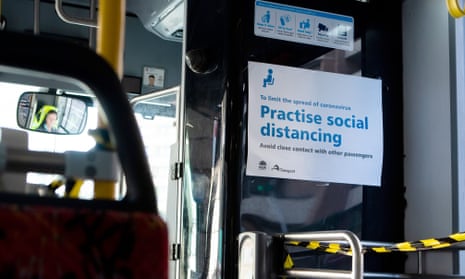The prime minister, Scott Morrison, announced on Tuesday that Australia must work to “flatten the curve of unemployment” caused by coronavirus, encouraging workplaces to become “Covid-safe” so they are on track to reopen by July.
The government recently overhauled its Safe Work Australia website to include industry-specific guides for reopening workplaces to limit the spread of Covid-19.
Many industries, such as aged care, healthcare, mining and education, are told to adhere to the advice of their respective governing authorities.
But Safe Work does provide detailed guides for businesses in the hospitality, retail and ride-share industries, and those working in generic office environments.
So what are some of the ways these workplaces could change should they reopen in the coming months?
Everyone needs to keep their distance
Everyone should stay 1.5m apart from others and, in any given space, there should be four metres of space per person where possible, according to the Department of Health.
To ensure this, some workplaces may have different staff coming into the office on different days. Retailers should use contactless payment and limit the number of customers allowed into their shop at the same time.
For workers such as taxi drivers, it might be physically impossible to keep a 1.5m distance between themselves and the customer. One suggestion on the Safe Work website is for taxi and ride-share drivers to install a perspex screen between the front and back seats.
The end of all-staff meetings and communal lunches
All non-essential gatherings, meetings and training should be postponed, cancelled or conducted via tele or video conferencing.
In fact, workplaces should also try to stagger meal breaks and start times to reduce the number of workers using common spaces at the same time.
Australia’s chief medical officer, Brendon Murphy, said on Tuesday that staggering start and finish times could also help ease public transport congestion.
“We don’t want everybody crowding on public transport at the same time, we don’t want everyone crowding in the lifts at the beginning of the day and the end of the day,” he said.
Cleaning, cleaning, cleaning
Workplaces will have to be cleaned at least daily using detergent, and disinfected as needed depending on how high-traffic the area is.
In retail stores, that means regularly cleaning counters, phones, Eftpos machines and even clothes racks.
It may be difficult to disinfect high-contact areas multiple times in a shift; in those cases a workplace may need to limit the number of people coming into contact with that area.
For taxi drivers, this may mean telling passengers not to open the doors from the outside themselves to avoid disinfecting the handle after each ride. For those in an office space, it may mean the end of hot-desking.
On-site temperature checks
SafeWork acknowledges that there may be times where it is reasonable for employers to administrator temperature checks to staff when they reopen. These include situations where staff live together in accommodation, such as agricultural workers, or in workplaces where vulnerable people are, like aged care facilities.
But on the whole, a temperature check isn’t going to definitively prove someone has Covid-19, and SafeWork says “there may be little benefit”.
What do the experts say about a return to work?
In terms of whether this is the right time for businesses to open up again, leading epidemiologist Prof Tony Blakely says “there is absolutely no question”.
“Everything comes down to whether the goal [in Australia] is elimination or suppression [of the virus],” Blakely says. “Assuming we are going for suppression, then absolutely we should try and open things back up, but it should be done in tranches.
“We need to accept there will be some low amount of community transmission, but we need to stamp those cases out as quickly as we can.”
But Dr Libby Sander, assistant professor of organisational behaviour at Bond University, says Safe Work’s guidelines pose challenges that may deter some businesses from inviting staff back into the office.
“There is a lot of discussion about bringing teams into offices on certain days,” she says. “But if there was hot-desking in place, which is the case for a lot of high corporates in Australia, there would have to be a deep cleaning done at the end of the day before the next shift comes in. This is a significant change and cost for a lot of businesses.
“I also think the genie is out of the bottle that working from home is possible and we can’t go back on that. We will see that people will work from home two days a week, maybe.”
